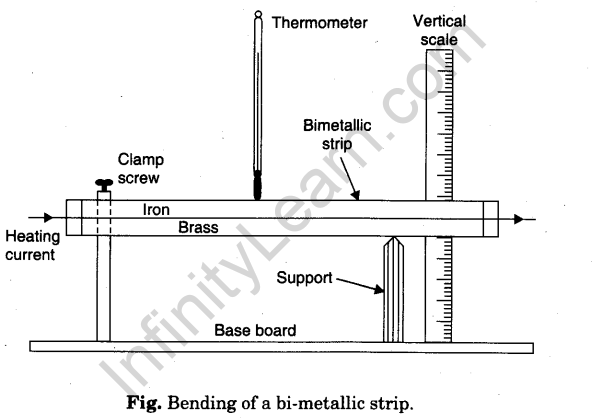To Observe and Explain the Effect of Heating on a Bi-Metallic Strip
Aim
To observe and explain the effect of heating on a bi-metallic strip.
Apparatus
A bi-metallic strip (made of iron and brass bars), a board with clamp screw on one side and vertical scale on the other side, electric heating arrangement, or a burner thermometer.
Short Description of a Bi-metallic Strip
It is a strip made up of two bars of different metals but same dimensions, put together lengthwise and ripetted at their ends. The strip is straight at room temperature.

When the bi-metallic strip is heated both bars expand differently. Since they are ripetted at their ends, their ends stay together. The bi-metallic strip bends keeping more expanding bar on its convex side. More is heating, more is the bending.
In case of an iron-brass bi-metallic strip, the bent strip will have brass bar on its convex side.
Theory

If two rods of different metals have same length L1 at temperature t1°C, their length at higher temperature t2 °C will be different. The rod of a metal having more value of ‘ coefficient of linear expansion will have more length than the other rod.
Diagram

Procedure
- Clamp one end of the brass-iron bi-metallic strip, keeping brass bar on the lower side.
- Keep the strip horizontal rested on a vertical support.
- Fix a vertical scale near the free end of the bi-metallic strip.
- Suspend a thermometer with its bulb touching the strip in the middle.
- Note the initial temperature of the strip.
- Note the vertical scale division coinciding with the upper edge of the strip.
- Heat the strip by passing electric current through it or by using a burner. The thermometer will show a rise of temperature.
- Watch the movement of the free end of the strip. The strip bends upwards (towards iron bar side) and position of upper edge of the strip changes.
- Note the temperature after each rise of temperature by 2°C and also the position of the upper edge at that temperature.
- Record your observations as given below.
Observations
Room temperature = 30°C (say)
Least count of vertical scale = 1 mm.
Table for temperature and vertical scale reading

Calculations
- Find the amount of bending by taking difference of position with initial position.
- It is found that amount of bending increases as temperature rises.
Result
- Bi-metallic strip bends more and more as its temperature rises.
- Since brass bar is on convex side and iron bar on concave side of bent bi-metallic strip, brass bar expands more than the iron bar. Hence brass has larger linear expansion.
Precautions
- The two bars should be firmly ripetted near their ends.
- Brass bar should be kept on the lower side.
- One end of the bi-metallic strip should be screw clamped.
- Heating of whole bi-metallic strip should be uniform.
Sources of error
- The ripettes may be loose.
- Heating of strip may not be uniform.





